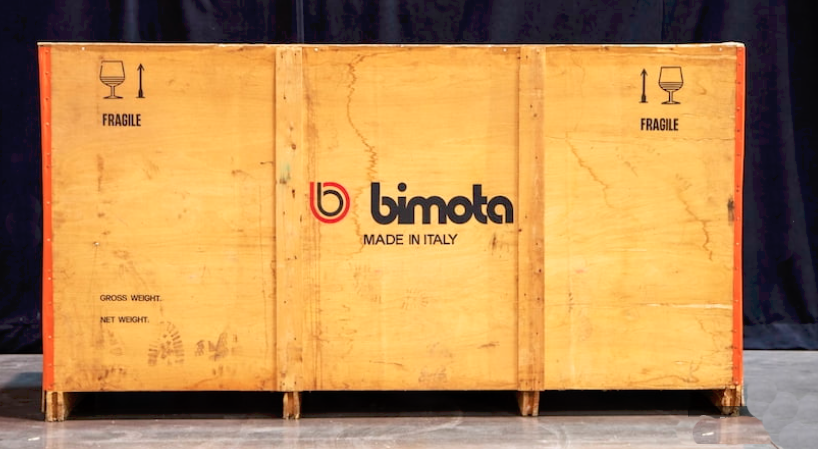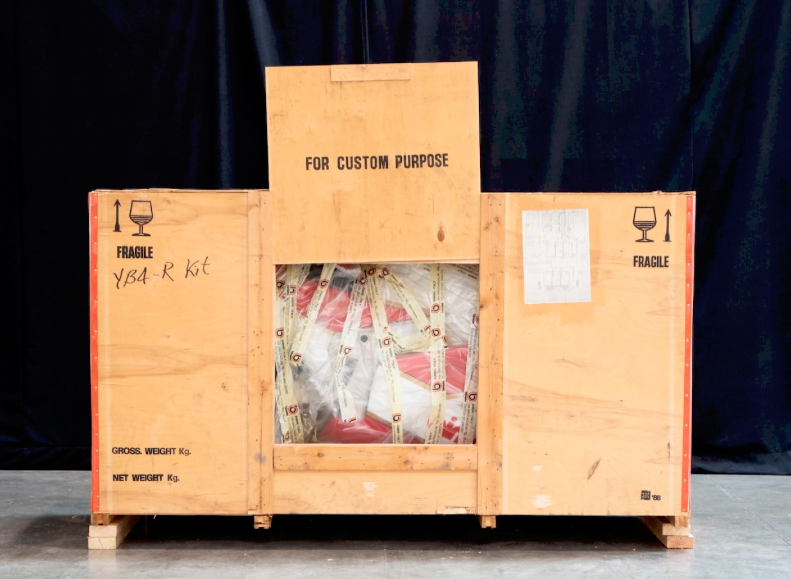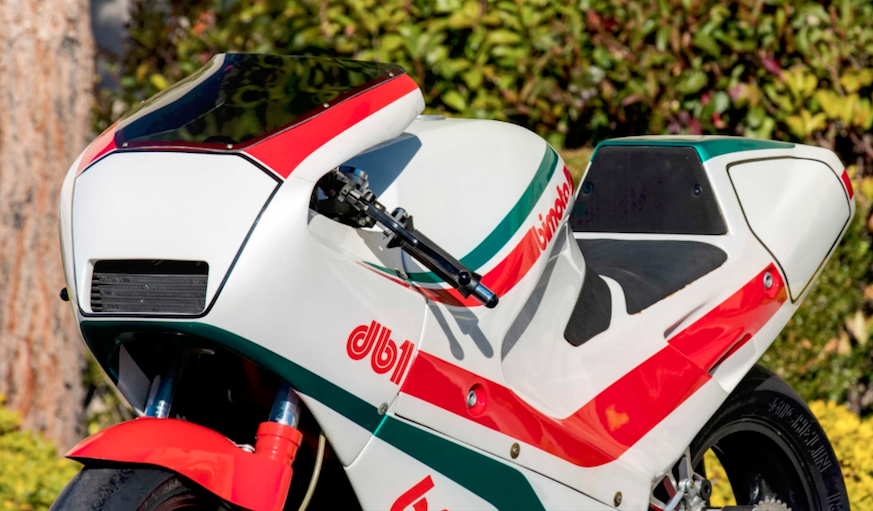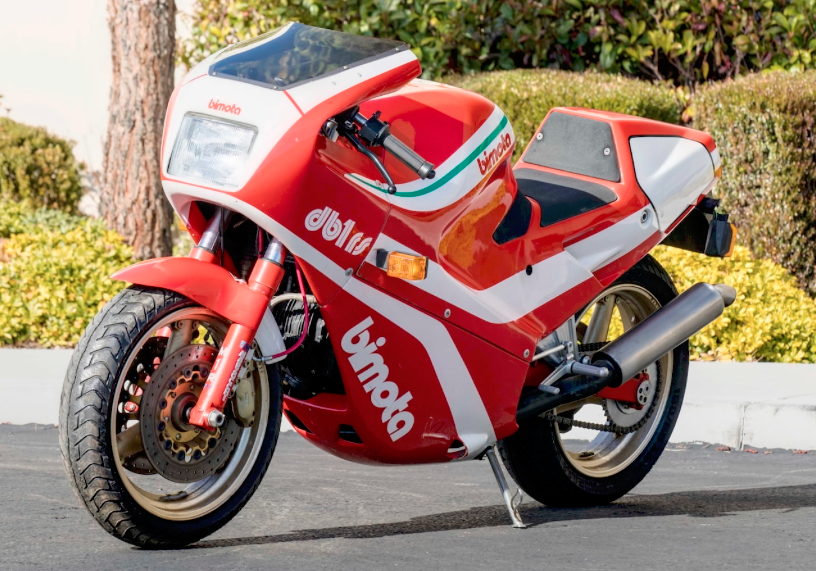Nick Drake, Vincent Van Gogh, and Bimota: sometimes real appreciation for your work comes after you’re dead. Like any creative innovator ahead of its time, Bimota built exquisite, hand-crafted motorcycles in tiny numbers, that were adored by the few who could afford them, and puzzled over by the motorcycling world at large. But we foresee Bimotas marching into the celebrity spotlight as a seriously collectable marque in the near future, as Bimota changed the motorcycle world in nearly every metric of chassis design and build quality. This little Italian moto maker was a giant killer both technically and creatively, combining their innovation in frame design and manufacturing with amazing styling, especially in their early years under co-founder Massimo Tamburini, who went on to design acknowledged masterpieces with the Ducati 916 and MV Agusta F4. If there is a worthy post-war inheritor of the Brough Superior mantle of ‘luxury motorcycle’, we would argue it should be Bimota: their build quality was insanely high, their styling was superb and led the industry, and their bikes proved their worth in competition by winning many racing series over the years, and they were never built to a price, but priced according to the build.
This year’s 2020 Mecum’Auction will showcase the largest sale of this insanely cool and impossibly rare Italian marque ever at one auction. They all hail from the Musée L’Epopée de la Moto Collection, and most were purchased from the collection of Francesco Romanelli. Here’s what’s coming:

This 1978 Bimota KB1 is a gorgeous, restored, first-year and first-ever example of a Bimota-Kawasaki hybrid. Early Bimotas are finally gaining the attention they deserve in the marketplace, as these were the most finely-crafted motorcycles in the world in the 1970s, with amazingly innovative chassis design, wild 1970s styling, and the best road performance money could buy. The KB1 was introduced in 1978, and was Bimota’s second street-legal motorcycle. The KB1 was a successful model for Bimota, with more than 800 units produced over four years. Their styling, with a full fiberglass fairing and distinctive tank/seat unit, is pure 1970s, but unlike any other production motorcycle of the era in both style and performance. The top speed for most KB1s was 140mph, but at least one version tuned by Termignoni reached 172.5mph. The KB1 weighed 425lbs, and could pull an 11.4second quarter mile time.

Crated? CRATED? Yes, this legendary bike has yet to be pulled out, filled with the necessary fluids, and let loose on the world. The question is, do you keep the toy in its packaging, or take it out and do a bit of time traveling? The SB4 was the fourth iteration of their collaboration with Suzuki, using the 1075cc DOHC 4valves/cylinder four-cylinder motor from the Katana 1100. The engine was mildly tuned at Bimota, using a freer exhaust and carburetion combination to give 112hp at 8750rpm, and a 153mph top speed. The frame is built of chromoly tubing, with a structural member of Avional aluminum machined from solid billet that connects the lower frame rails with the upper structure that connects the steering head with the monoshock rear suspension mount. This was likely the first use of CNC-machined billet aluminum as a structural member on a production motorcycle, and is indicative that innovation was important at Bimota. Only 272 Bimota SB4s were built in 1983 and ’84, making any version of this bike super rare… So, what does that make a version still in the crate?

This doubly all-Italian Bimota-Ducati hybrid is factory fresh, and might be the only example of a rare 1986 Bimota DB1S still in its original delivery crate. Amazingly, Bimota had only used engines from Japanese manufacturers from its early 1970s origins. Thus the first actual Bimotas were built around the Honda CB750 motor, and were followed by machines built around Suzuki, Kawasaki, and Yamaha fours. The first Italian motor to power a Bimota was a Ducati Pantah, and marked a turning point for the factory in many ways. The original Bimota partner/designer Massimo Tamburini took employment in larger motorcycle factories, and was replaced by Federico Martini. Martini’s bold step was to create a totally enclosed motorcycle with a fully integrated fairing system, which was the first of its type in the world. There were other innovations throughout the machine, which included a new type of upper space frame, a molded polyethylene fuel tank, and the integration of hydraulic fluid containers for the brakes and clutch into the fork triple clamps. The DB1 was the whole package, innovation and performance and beauty, which characterized all Bimotas from the start of the company, and made them instant collectibles from day one. This 1986 Bimota DB1S is one of 60 examples ever built, continuing this collection’s ‘impossibly rare” theme.

It’s nearly unheard of to find an example of the premier production racing motorcycle in the world from 33 years ago, still in its crate from the factory, but that’s the case with this remarkable 1988 Bimota YB4 R. This is the sister machine in kit form sold by Bimota to their own factory racing YB4 R that took the World TT F1 Championship in 1986. The YB4 introduced the first modern aluminum beam chassis for a road bike, built from castings and forgings of Anticorodal aluminum alloy for the frame and swingarm both. The YB4 R was sold as a whole motorcycle or as a ‘kit’ to save on customs duty, as with this machine, which is a whole motorcycle slightly disassembled for a nominal kit status. Clearly, this machine has never been removed from its crate or unwrapped from its plastic packing, and thus remains as new from the Bimota factory. At risk of killing my rarity point, there is somehow a second 1988 Bimota YB4 (although the Weber-Marelli electronic fuel injected version) also going to auction. I would argue this second crated YB4 doesn’t take away from how insanely rare these are, but simply highlights how incredible the 2020 Mecum’s auction will be.

This gorgeous 1988 Bimota DB1 R is a very rare example of factory racing Bimota, built with a Ducati racing engine, and based on the roadster DB1 model. The DB1 was Bimota’s first all-Italian street model, using a tuned 750cc Pantah engine in Frederico Martini’s amazing, all-enclosing bodywork. The DB1 R is a highly modified version of the roadster, with quite a few parts made of magnesium, plus forks with a steeper steering head angle for racing (29° vs. 25°, with identical trail at 105 mm), high-performance cams, 42mm carburetors, an open two-into-one megaphone exhaust, higher rearsets, and about a million other fun things to make it unfit for the civilized world of public roads. The DB1 R was typically raced in TT1 Italian and F1 World Championship events, and was also seen in the Daytona 200.

This super sports 1988 Bimota DB1 SR racer is the last and hottest of the DB1 Bimota-Ducatis, and the best of the bunch, with more power and sharper handling. The DB1 SR roadster was not a whole lot slower than the factory racer, and won lucky test riders and owners over with its peerless combination of perfect handling in all conditions and weathers, and quick, willing power across a broad rev range. Only 153 were built, making this a rare motorcycle indeed, and one remembered with tremendous affection. This was reflected in their cost, of course, and as the saying goes, you get what you pay for. What one paid for with the Bimota DB1 SR was the full attention of a small factory of speed-mad Italian craftsmen, who were dedicated to bringing the finest workmanship and rider experience possible in a sports motorcycle.

This is an incredibly rare piece of history from the giant-slaying tiny factory from Rimini. The Bimota YB6 Tuatara was a special fuel-injected edition of the YB6 range, with 145hp at 9500rpm from its 1000cc Yamaha engine, and an incredible for the day top speed of 170mph. The YB6 was, like all Bimotas, a finely crafted instrument, built by hand by master craftsmen who were dedicated to making the best sports motorcycles in the world. From the fork stanchion and triple trees to the axles and rearsets, the parts of the YB6 are hand-machined, ultra light, and simply gorgeous. Moto Sprint called it, “a machine which can offer enormous satisfaction in driving, even though in all likelihood most of the lucky owners will prefer to transform this bike into a cult object, strictly to be admired, rather than subject it to the torture of the track.” The YB6 Tuatara is indeed a cult machine that is gaining traction with the public as an object of tremendous historical value, and this is perhaps the finest example in the world.
Two more Bimotas for sale at Mecum don’t hail from the Musée, but are worth considering as well:

The YB10 used a tuned Yamaha FZR1000 motor giving 145hp @10,000 rpm, and a 172mph top speed, which made it the fastest production motorcycle in the world…although that production was extremely limited. Only 224 YB10s were built, but what machines! Here’s what the press said, “Built with an almost maniacal attention to detail, the Dieci is even better than the other Bimotas: the paint is particularly tough, the joints and connections are particularly precise, and there are even lovely little frills of all sorts, such as pull rods, pegs, and knobs- machined, not cast – which drive a real motorcycle fan mad; now there is even a little compartment for personal objects in the tail of the bike. Because of the splendidly harmonious chassis, the handling is phenomenal, even at the most extreme angles.” (Moto Sprint, 1991). In other words, another masterpiece from Rimini.

The YB8 is basically the same machine as the YB6 Exup, using the Yamaha FZR1000 engine, but tuned for 148hp @10,000rpm. Only 252 YB8s were built for discerning international customers, and what they got for their 27.5Million Lire was the highest quality, highest-performing motorcycle in the world, by every reasonable metric. Every part of the Bimota is hand fabricated, hand machines, and hand assembled, with exceptionally high standards. This is the first machine designed by Pier Luigi Marconi, who took over the reins from Federico Martini in 1990, and the styling set the standard for the sports motorcycle industry for ten years. The performance, perhaps longer. The workmanship…well, nobody’s caught up to that yet.

Related Posts
December 21, 2018
The Vintagent Selects: The MC Collection Of Stockholm // Mecum Las Vegas Motorcycles 2019
This is the MC Collection.




My personal favorite Bimota and the most usable as well as the most ignored / panned ?
The Bimota Mantra . A more intelligent urban commuter ‘ sport ‘ bike ‘ fully capable of moderate distance touring ( with the correct luggage ) has yet to be created .
THE Bimota for the genuine iconoclast who seeks function first along with enjoying the ride and a genuine sense of French Jolie Laide quirkiness ( versus boy racer homogenization pretense of fashion ) completely with Italian underpinnings having no need to prove anything to anybody ,
Sigh … genuine individuality and iconoclasm . An all but dead zeitgeist in the era of suburban urban hipster wanna be digital / virtual sameness .
Rock On ( if any of you still know how ) Remain Calm ( while practicing passive resistance / civil disobedience ) but don’t keep Carrying On like the majority of you are so far .. placing all your emphasis on homogenized ‘ coolness ‘ ( which aint cool in the slightest ) and the almighty mammon ( $ )
😎
Francesco Romanelli, I have not heard that name for some time. I bought a nos RGS Laverda from him in Montreal in the late 80’s. What a character. His collection was amazing as was his knowledge and wit. He would make me laugh non-stop as we talked about everything around us including politics. And I could not believe these machines he had all over his premises. I had only heard of them or seen a few photos in magazines. After I got to know him he eventually asked me if I wanted to buy a bike and we made our way through his warehouse. I talked my way into the RGS on my limited budget and we struck a deal. Very fair. Last time I saw him he told me he was tired of the politics in Montreal and was moving to New York state.